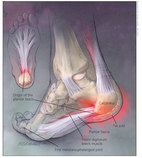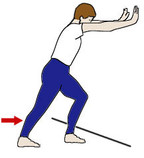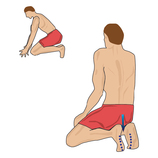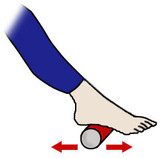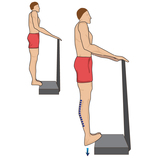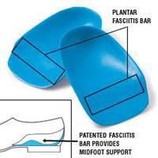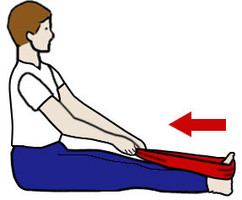
Plantar Fasciitis: A Common Cause of Heel Pain
The plantar fascia is a band of tissue, much like a tendon, on the bottom of your foot. It starts at your heel and goes along the bottom of your foot. It attaches to each one of the bones that form the ball of your foot. The plantar fascia works like a rubber band between the heel and the ball of your foot to form the arch of your foot. If the band is short, you'll have a high arch and if it's long, you'll have a low arch, or what some people call flatfeet. A pad of fat in your heel covers the plantar fascia to help absorb the shock of walking. Damage to the plantar fascia can be a cause of heel pain.
What causes the heel pain?
As a person gets older, the plantar fascia becomes less like a rubber band and more like a rope that doesn't stretch very well. The fat pad on the heel becomes thinner and can't absorb as much of the shock caused by walking. Damage to the plantar fascia may cause it to swell, tear or bruise. You probably have pain in your heel when you stand up for the first time in the morning. Most people with plantar fasciitis say the pain is like a knife or a pin sticking into the bottom of the foot. After you've been standing for awhile, the pain becomes more like a dull ache. If you sit down for any length of time, the sharp pain will come back when you stand up again to walk.
What can I do about the heel pain?
If you walk or run a lot, cut back a little. You probably won't need to stop walking or running altogether.If you have either flatfeet or a high arch, ask your doctor about using orthotics, or inserts for your shoes. Orthotics are arch supports. You will need to be fitted for them.If you are overweight, losing weight can help lessen your heel pain. If your job involves standing on a hard floor or standing in one spot for long periods, place some type of padding on the floor where you stand.Also, try icing the heel for about 20 minutes around bedtime every night for at least 2 weeks.
Are there any exercises that will help?
Do the stretches as shown against the wall holding for 10 seconds. You must do 100 repetitions per day. Less than 100 reps will not be effective, and not doing them every day will not be effective. Don't bounce when you stretch. You can also strengthen your leg muscles by standing on the ball of your foot at the edge of a step and raising up as high as possible on your toes. Relax between toe raises and let your heel fall a little lower than the edge of the step. It's also helpful to strengthen the foot by grabbing a towel with your toes as if you are going to pick up the towel with your foot. Repeat this exercise several times a day.
Will any medicine help?
Ibuprofen (Advil, Motrin) or prescription anti-inflammatory medications can ease the heel pain, but talk to your doctor before you take any medicine.
How to perform stretch:
Kneel down with your toes bending upwards
Lower your buttocks towards your heels
Apply pressure to your heels until a stretch in the arch of your foot and the Achilles tendon region is felt
The plantar arch and the toe flexors are stretched along with Achilles tendon. It helps to relieve stiffness in the sole of the foot, especially beneficial for the treatment of Plantar Fasciitis (pain in the heel or the sole of the foot) and Shin Splints (pain along the inside of the lower end of tibia). The ankle flexes up to about 20 degrees from normal standing position, further joint mobility restricted by the stretch in the calf muscle. Plantar arch, fascia and the ligaments should all stretch tightly. Toes flex from 54 to 73 degrees
What if my foot still hurts after doing the exercises, using the arch supports and taking other measures?
If stretching, arch supports, medicine and exercises don't help, your doctor can suggest other treatments. You may need to wear splints on your foot at night, tape your foot or have injections of corticosteroids into the plantar fascia. In a very few cases, surgery is needed. You and your doctor can decide which treatment is best for you.
How to perform stretch:
Stand on the edge of a ledge (somewhere stable like the stairs or the gutter is ideal). You will need to have enough of your foot on the edge of the ledge so it does not slip off.
Make sure you are stable, this will allow you to hold your stretch for a longer period (better quality of stretch)
Lower both heels over the edge of the ledge
Advanced Stretching Techniques:
Try lowering one leg at a time. This increases the weight on the calf muscle and increase the intensity of the stretch.
To specifically target the Soleus muscle bend both knees. You will feel the stretch move lower and to the inside of the shin.
